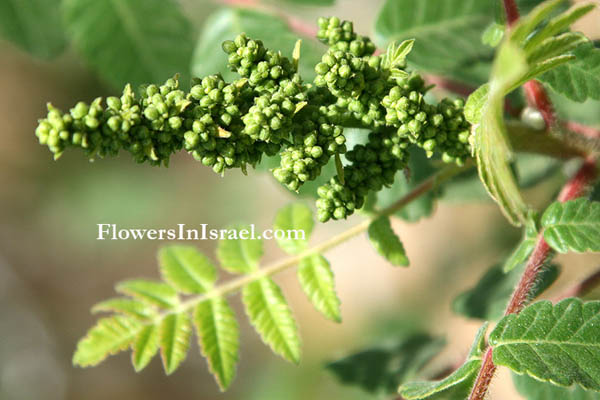Hebrew: אוג הבורסקאים, Arabic: سمّاق, Summaq
| Scientific name: | Rhus coriaria L. | |
| Common name: | Tanners Sumach | |
| Hebrew name: | אוג הבורסקאים | |
| Arabic name: | سمّاق, Summaq | |
| Family: | Anacardiaceae, משפחת האלתיים |

|
| Life form: | Phanerophyte shrub | |
| Leaves: | Alternate, compound, dentate or serrate | |
| Flowers: | Green | |
| Flowering Period: | April, May | |
| Habitat: | Mediterranean maquis and forest | |
| Distribution: | Mediterranean Woodlands and Shrublands, Montane vegetation of Mt. Hermon | |
| Chorotype: | Irano-Turanian | |
| Summer shedding: | Perennating |

Derivation of the botanical name: Rhus, latinization of the plant’s Greek name, rhous, ῥοῦς, commonly called sumac. Sumac is of Semitic origin, deriving from a root SMQ or ŚMQ “to be red”. In Modern Hebrew sumak, סומאק, means the spice exclusively. The name was transported to European languages via Arabic as-summaq, السماق, “sumac”. coriaria, corium, κοριον, "animal skin, hide", leather; arius, "connected to or possessed by"; leather like. The Hebrew name: אוג, og, from Syrian איגא, Iga; Post Biblical Hebrew: sumach (kind of a tree).
Tannines are found in all parts of the plant, with particularly high concentrations in bark and root. These plant parts were used for tanning leather since antiquity. Tanning is the process of making animal hides into leather; Rhus coriaria yields sumac spice. The fruits are ground into a deep-red or purple powder used as a spice in Middle Eastern cuisine to add a lemony taste to salads or meat. Pliny the Elder (23-79 CE):
The only references to a tanner are in Acts 9:43; 10:6, 32. The bursi, בֻּרְסִי (Greek: byrsa, skin, עור) was the dresser of the hides, the tannery was called burseki, בורסקאי, the hide when it was being processed was called bursiyyon; in time bursiyyon was used for the tanning process and finally for the tanner himself). Peter, of the Twelve Apostles, stayed at the house of Simon the tanner when he was at Joppa (Acts 9:43). The Jews looked upon tanning as an undesirable occupation, it was regarded with aversion, as it necessitated more or less of ceremonial uncleanness, especially if the skins of unclean animals were dealt with. The fact that Peter did not hesitate to lodge in the house of a tanner indicates that he had already become somewhat liberal in his views regarding the ceremonial law. Simon's house was by the seashore, as is true of the tanneries along the Syrian coast today, so that the foul-smelling liquors from the vats can be drawn off with the least nuisance, and so that the salt water may be easily accessible for washing the skins during the tanning process. According to the Mishnah (BB 2:9) a tannery should be situated on the east side of the town only, at least 50 cubits from the outskirts. This was because tanning was a primitive, malodorous process. The tanner's trade was among those from which neither king nor high priest might be appointed, not because the tanner is ritually unfit, but because his occupation is despised. Maimonides, Rambam, Moses ben Maimon (1135-1204), adds (Yad, Melakhim 1:6) that whoever has worked at this trade for even one day is unfit for the high offices. These tanneries are very unpretentious affairs, usually consisting of one or two small rooms and a courtyard. Within are the vats made either of stone masonry, plastered within and without, or cut out of the solid rock. The sheep or goat skins are smeared on the flesh side with a paste of slaked lime and then folded up and allowed to stand until the hair loosens. The hair and fleshy matter are removed, the skins are plumped in lime, bated in a concoction first of dog dung and afterward in one of fermenting bran. The bated skins are tanned in Sumac, Rhus coriaria or Rhus oxycanthoides, which is the common tanning material in Syria and Israel. After drying, the leather is blackened on one side by rubbing on a solution made by boiling vinegar with old nails or pieces of copper, and the skin is finally given a dressing of olive oil. For dyeing the rams' skins red (Exodus 25 ff) they rub on a solution of qermes [Kermes biblicus, known as kermez in Arabic, the cochineal insect, or shield louse, that lives on oak trees in the Holy Land (cf. Pliny 21:22, “red, as of the kermes-insect…”)], dry, oil, and polish with a smooth stone. Leather was probably used more extensively than any records show. There are two Biblical references to leather, where leather girdles are mentioned:
|